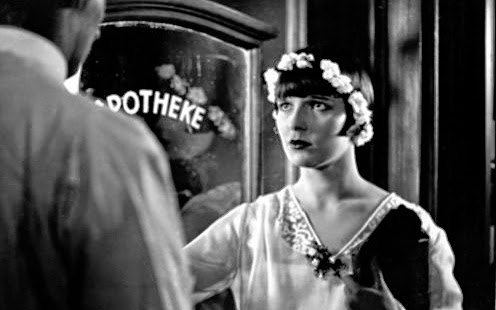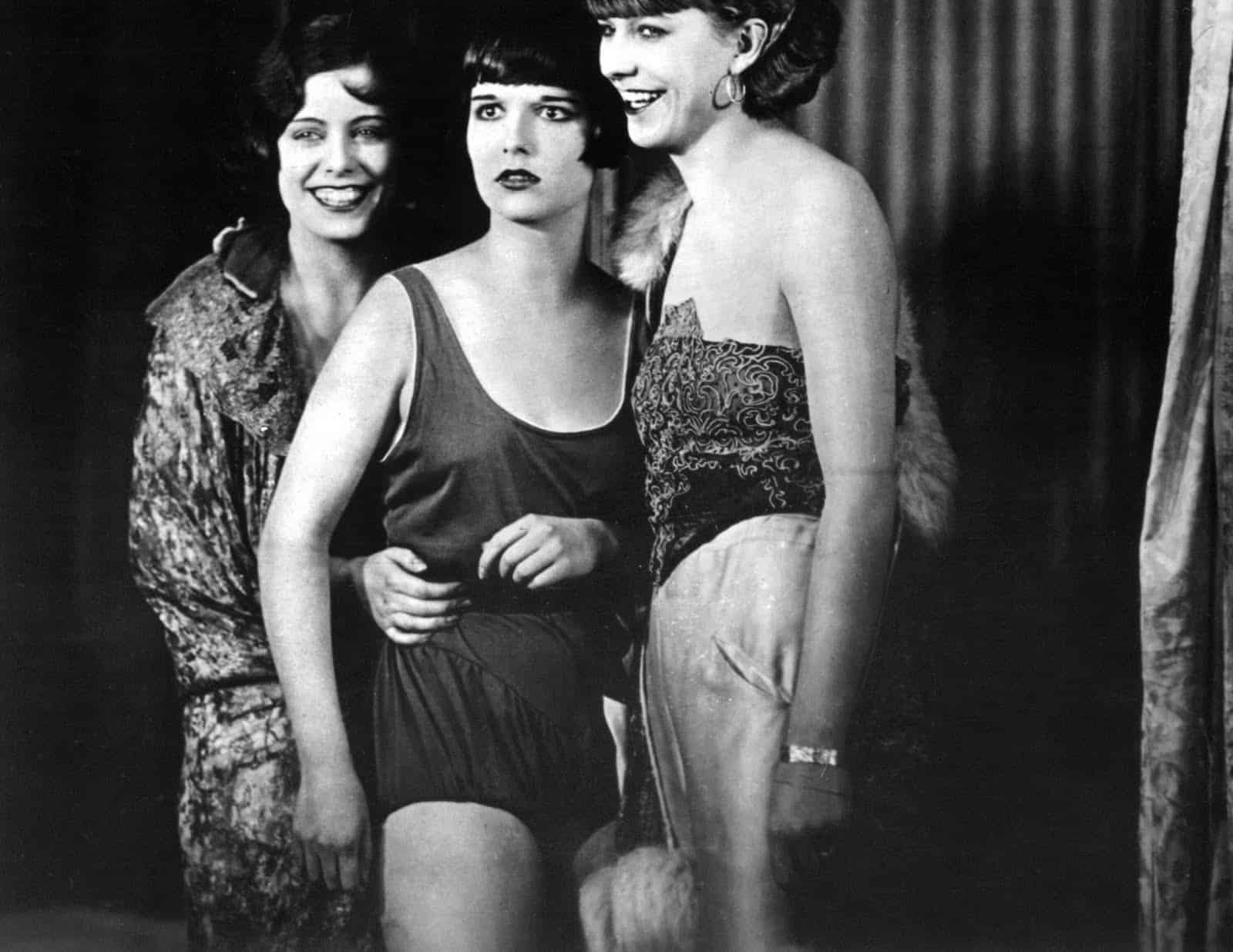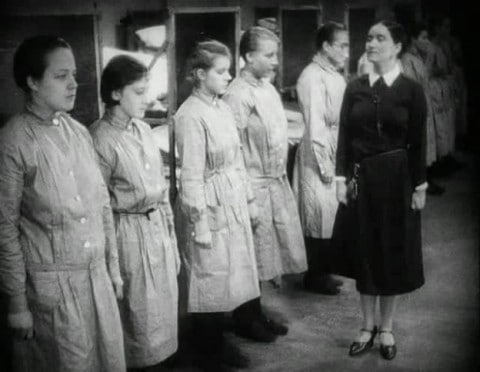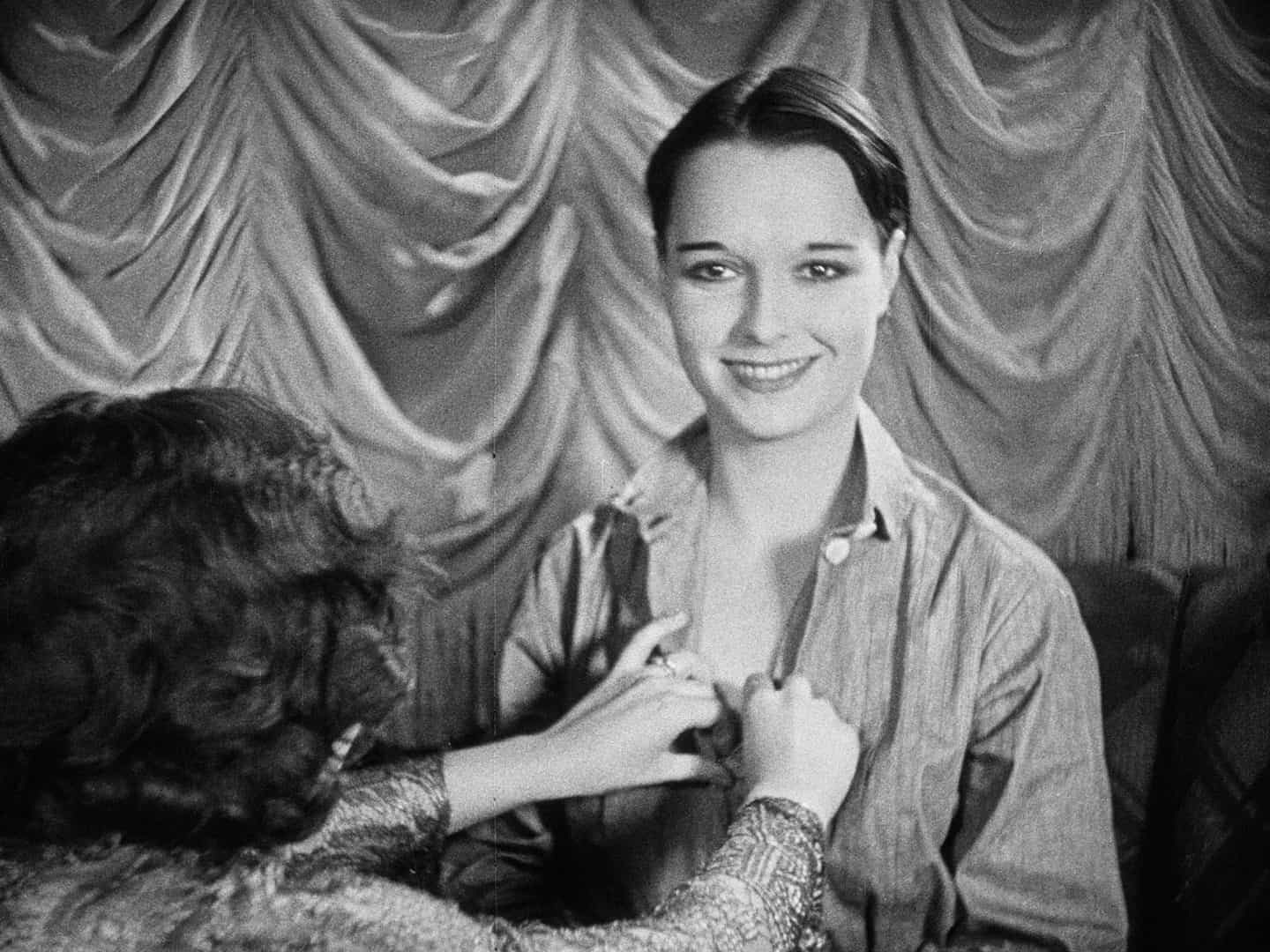In just two collaborations, the German director Georg Wilhelm Pabst and the Kansas-born Louise Brooks created a screen personality that left a permanent mark on the history of film. The iconic Brooks—impeccably dressed, seductively smirking, short, jet-black hair—had been seen in films prior, most notably in Howard Hawks’ A Girl in Every Port (1928), but it was in Pabst’s Pandora’s Box and Diary of a Lost Girl (both released in 1929) that this embodiment of tumultuous 1920s mores struck a strong and enduring chord.
Brooks in these two Pabst features could not be more dissimilar, however. Lulu, the freewheeling temptress of Pandora’s Box, is miles away from Thymian, the young, naive innocent of Diary of a Lost Girl. As this latter feature begins, Thymian enters the picture all in white, in accordance with her recent confirmation. She is a virginal image standing in sharp contrast to the enveloping immorality that surrounds her; the flowers in her hair point toward a natural purity that is repeatedly offended by the modern world and all its brutality.
For Thymian Henning, this brutality comes in many forms. There is her father’s assistant, Meinert (Fritz Rasp), who sexually assaults the adolescent girl resulting in their illegitimate child. Then there is Meta (Franziska Kinz), the family’s new housekeeper, who arrives after Thymian’s father, Robert (Josef Rovenský), impregnates the previous one, something he is apparently wont to do; the attractive Meta’s appearance causes shrewd grins from the men and disdainful glances from the women. Assuming the role of Thymian’s primary nemesis, the conniving Meta discloses to the Henning family that Meinert is the father of the baby. After refusing to marry the deviant, Thymian is subsequently sent to a girl’s reformatory while her daughter is given to a midwife. At the reformatory, Thymian and the other young women are subjected to an assortment of abuses. This institution where uniformity and regimentation rule supreme is also a twisted haven of unwelcome lesbian advances (conveyed most disturbingly when the headmistress leers with perverse orgiastic ecstasy at the exercising girls).
Managing to escape with the assistance of family friend Count Osdorff (André Roanne), Thymian joins fellow reformatory inmate Erika (Edith Meinhard) at a brothel. Thymian thinks she can work by simply giving dance lessons, but in her ignorance, she is quickly in for more than she bargains for. It briefly appears the once prosperous Osdorff could come to the rescue of Thymian, but having been disowned by his wealthy uncle he is now a penniless wastrel. Together, the two comprise what Meta refers to as “the vagabond and the lost girl.” Thymian is obviously falling in with the wrong crowd, but with nowhere else to go, it is better than the alternative, even if still not the best.
Some time later, Robert and Meta visit a nightclub where Thymian happens to be “entertaining,” and her father discovers just what his little girl has been up to; that he would be bothered by her lifestyle is, of course, the height of hypocrisy. Having left his wife, Robert is soon in debt to Meinert and Meta is soon with child. Not long after, he dies, and the disclosing of his will intensifies the animosity between all involved.
Still, despite all the wrong she has been victim to, Thymian nevertheless attempts to do the right thing. There are moments toward the end of Diary of a Lost Girl when the potential for contentment seems imminent, but no sooner do these glimmers of optimism occur than they are quickly upset by a world that remains marred by suicide, exploitation, deceitfulness, and contemptuousness. And it’s a pervasive and wide-ranging world of despair. Once it becomes clear that Thymian is fully lodged in a life of ill repute, a dissenting club patron says she is now truly lost, “just like the rest of us.”
Thymian is a perpetual victim of circumstance, the byproduct of poor luck and her generally harsh environment, particularly her familial upbringing. Mother Henning sits idly by in the face of her philandering husband but is quick to scold Thymian. Her father, meanwhile, does express a degree of sympathy toward his daughter’s predicament, even though it’s clear what kind of a man he is (perhaps that is why he is less quick to judge). As legendary German film scholar Siegfried Kracauer states, “Pabst harps on the immorality of her middle-class environment, so that the brothel almost appears to be a health resort.” Here, as in the so-called “street films” that were prevalent in Germany during the period, Kracauer writes that, “[T]he prostitute with the heart of gold testifies against the bourgeois decadence.” Thymian lives a life spoiled by those who take advantage of her ingenuousness and by those whose selfishness and unfeeling apathy leaves them bitter and cold. The midwife exemplifies this callous, casual cruelty. When Thymian goes to retrieve her daughter, the woman smugly shrugs her shoulders and simply states, “She just died,” which we assumed when Thymian passes a man carrying a child-sized casket. If the final lines of the film— “With a little more love, no one on this earth would ever be lost!” —ring a little false and hokey, it is because of the all the nastiness we have bore witness to for the previous 112 minutes. It will take more than a little love to save this world.
To be sure, Diary of a Lost Girl is a real downer. Based on the novel by Margarete Böhme and with a script by Rudolf Leonhardt, who also wrote Pabst’s The Love of Jeanne Ney (1927), the film is an excellent example of the type of social realism that surpassed Expressionism as the key German cinematic export. Befitting the categorization of New Objectivity, camera movement is largely limited (though there are some impressive exceptions), compositions are sparse and deliberate, and the flat staging clears the way for a population of frosty, pitiless faces, most of whom contrast sharply with the radiance of Brooks but do match the equally unforgiving settings. This film, writes Lotte Eisner, another major figure in the chronicling of German film history, “displays a new, almost documentary restraint. Pabst now seeks neither Expressionistic chiaroscuro nor Impressionistic glitter.” As a stylistic counterpoint, see Fritz Lang’s Metropolis (1927) and Spies (1928), both from around the same period. Pabst not only stresses a more pronounced naturalness in the performances, but he also prefers the forcefulness of intense shot selection resulting from confrontational and revealing close-ups, rather than dynamic montage or intricate mise-en-scène.
The reconstruction and restoration for the new Kino Lorber Blu-ray of Diary of a Lost Girl was performed by several institutions, most prominently Friedrich-Wilhelm-Murnau-Stiftung. Not only were a range of technical issues rectified and repaired, but the release also emphasizes the efforts made to reinstate sections omitted or revised due to the censorship of the time. Diary of a Lost Girl is surely a surprisingly risqué film, further contributing to the sexual connotations of Brooks’ persona. Nothing explicit is shown, but plenty is daringly implied. For all of her present fame, however, Brooks was actually billed second, below Rovenský, who had more than 30 films to his credit by this point. But today, it is she who stands out. Eisner at one point wondered if Brooks was, “a great artist or only a dazzling creature whose beauty leads the spectator to endow her with complexities of which she herself was unaware?” As she later concluded, quite rightly, Brooks was both. Though she would only do another five features or so, and within 10 years, her acting career would be over, without her extraordinary charm and versatility, it’s hard to imagine that this film, like Pandora’s Box, would remain so emotionally engaging.





No comments:
Post a Comment